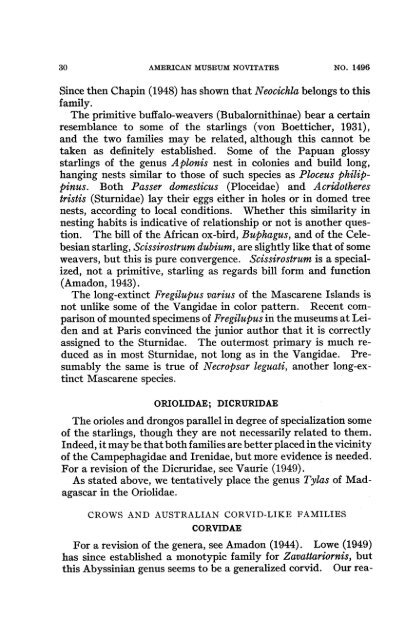NOVITATES - American Museum of Natural History
NOVITATES - American Museum of Natural History
NOVITATES - American Museum of Natural History
You also want an ePaper? Increase the reach of your titles
YUMPU automatically turns print PDFs into web optimized ePapers that Google loves.
30 AMERICAN MUSEUM <strong>NOVITATES</strong> NO. 1496<br />
Since then Chapin (1948) has shown that Neocichla belongs to this<br />
family.<br />
The primitive buffalo-weavers (Bubalornithinae) bear a certain<br />
resemblance to some <strong>of</strong> the starlings (von Boetticher, 1931),<br />
and the two families may be related, although this cannot be<br />
taken as definitely established. Some <strong>of</strong> the Papuan glossy<br />
starlings <strong>of</strong> the genus Aplonis nest in colonies and build long,<br />
hanging nests similar to those <strong>of</strong> such species as Ploceus philippinus.<br />
Both Passer domesticus (Ploceidae) and Acridotheres<br />
tristis (Sturnidae) lay their eggs either in holes or in domed tree<br />
nests, according to local conditions. Whether this similarity in<br />
nesting habits is indicative <strong>of</strong> relationship or not is another question.<br />
The bill <strong>of</strong> the African ox-bird, Buphagus, and <strong>of</strong> the Celebesian<br />
starling, Scissirostrum dubium, are slightly like that <strong>of</strong> some<br />
weavers, but this is pure convergence. Scissirostrum is a specialized,<br />
not a primitive, starling as regards bill form and function<br />
(Amadon, 1943).<br />
The long-extinct Fregilupus varius <strong>of</strong> the Mascarene Islands is<br />
not unlike some <strong>of</strong> the Vangidae in color pattern. Recent comparison<br />
<strong>of</strong> mounted specimens <strong>of</strong> Fregilupus in the museums at Leiden<br />
and at Paris convinced the junior author that it is correctly<br />
assigned to the Sturnidae. The outermost primary is much reduced<br />
as in most Sturnidae, not long as in the Vangidae. Presumably<br />
the same is true <strong>of</strong> Necropsar leguati, another long-extinct<br />
Mascarene species.<br />
ORIOLIDAE; DICRURIDAE<br />
The orioles and drongos parallel in degree <strong>of</strong> specialization some<br />
<strong>of</strong> the starlings, though they are not necessarily related to them.<br />
Indeed, it may be that both families are better placed in the vicinity<br />
<strong>of</strong> the Campephagidae and Irenidae, but more evidence is needed.<br />
For a revision <strong>of</strong> the Dicruridae, see Vaurie (1949).<br />
As stated above, we tentatively place the genus Tylas <strong>of</strong> Madagascar<br />
in the Oriolidae.<br />
CROWS AND AUSTRALIAN CORVID-LIKE FAMILIES<br />
CORVIDAE<br />
For a revision <strong>of</strong> the genera, see Amadon (1944). Lowe (1949)<br />
has since established a monotypic family for Zavattariornis, but<br />
this Abyssinian genus seems to be a generalized corvid. Our rea-

















